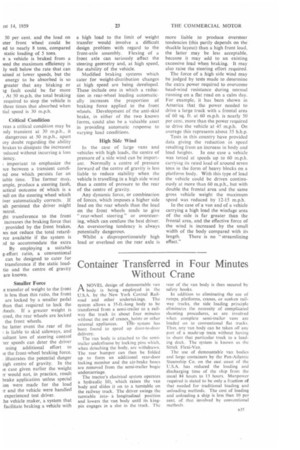Container Transferred in Four Minutes Without Crane
Page 69

If you've noticed an error in this article please click here to report it so we can fix it.
A NOVEL design of demountable van body is being employed in the U.S.A. by the New York Central Railroad and other undertakings. The system allows a 35-ft.-long body to be transferred from a semi-trailer to a railway flat truck in about four minutes without the use of cranes' hoists or other
external appliances. TN system has been found to speed up door-to-door delivery.
The van body is attached to the semitrailer underframe by locking pins which, when detaching the body, are withdrawn. The rear bumper can then be folded up to form an additional rear-door locking member and the air-brake hoses are removed from the semi-trailer bogie undercarriage.
The tractor's electrical system operates a hydraulic lift, which raises the van body and slides it on to a turntable on the railway truck. The driver swings the turntable intoa longitudinal position and lowers the van body until its kingpin engages in a slot in the truck. The rear of the van body is then secured by safety hooks.
In addition to eliminating the use of ramps, platforms, cranes, or sunken railway tracks, the side loading principle eliminates the necessity of complicated shunting procedures, as are involved when complete semi-trailer vans are loaded on to conventional flat trucks. Thus, any van body can be taken off any part of a made-up train without having to shunt that particular truck to a loading dock. The system is known as the Strick Flexi-Van.
The use of demountable van bodies and large containers by the Pan-Atlantic Steamship Co. on the east coast of the U.S.A. has reduced the loading and discharging time of the ship from the usual 84 hours to 13 hours. Manpower required is stated to be only a fraction of that needed for traditional loading and unloading methods. The cost of loading and unloading a ship is less than 10 per cent. of that involved by conventional methods.




















































































































